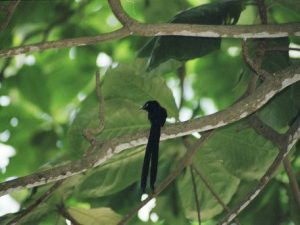The unspoilt islands of the Seychelles are the perfect nesting grounds for all sorts of wild life. This week we are going to show you the most well known and rarest birds of the Seychelles, the Black Parrot and Black Paradise Flycatcher.
Black Parrot
One of the most famous and most rare birds in Seychelles is the Black Parrot, or Kato Nwar in Kreol (Coracopsis barklyi).
Interestingly, the black parrot is not black at all, it’s actually a dark greyish brown with grey underrated coverts. It is not a large bird, at only 30cm in length.
We have previously written about the famous Vallee de Mai, where the Coco de Mer only naturally grows, which is often referred to as the Garden of Eden. Strangely, and perhaps to add more smoke to the fire of it being the Garden of Eden, this is the one of the limited breeding grounds for the Black Parrot as well, with the only other known areas being Fond Peper in Praslin National Park and on the neighbouring island of Curieuse. The Parrots breed in deep cavities old tree trunks and they typically lay 1-3 eggs.
The diet of the Black Parrot is principally fruit and some flowers and buds, including the flowers of the Coco de Mer palm. Fruits known to be eaten by the Black Parrot include papaya, gave, mango and bilimbi.
Sadly, there is thought to be less than 1,000 of these magnificent birds left in the wild. Although a protected species, it is at risk from its natural predators such as rats and in competition with other nesting birds.
I have spent a great deal of time searching the tree lines for a glimpse of this bird but sadly haven’t had the pleasure of seeing one (yet). Perhaps you will be lucky enough to spot one on your adventures in the Seychelles…
Black Paradise Flycatcher
The Black Paradise Flycatcher, or Vev in Kreol (Terpsiphone corvina) is actually a black bird… well, the male is, with two long tail feathers. The female is reddish-brown with pale underparts and no long tail feathers.
The length of the males is about 20 cm, with tail feathers reaching up to 30cm in length. The females can reach a length between 16 and 18 cm (including the tail).
Sadly, the Black Paradise Flycatcher is also an endangered species with numbers thought to be in the low hundreds.
Again, like the Black Parrot, this bird is endemic to the Seychelles and although once found across the Islands, is now only restricted to La Digue where is it quite commonly seen.
In an attempt to grow the population of this bird, 23 adult birds were relocated to Denis Island (Seychelles) in 2008, with the first chick successfully fledged there in 2009.
A special nature reserve has also been created in La Digue named the Veuve Nature Reserve to try and boost their numbers.
Unlike the Black Parrot, the Paradise Flycatcher preys on insects in flight or from a perch. It also feeds on larvae and spiders.
Their, oval bowl-shaped nests are built on branches and consist of twigs, palm fibre, and spider webs. Both parents, male and female, take care of the little birds until they grow up and each of them provide food, mainly in the form of flies for which this bird got its name.
During your time with us at Le Nautique La Digue, keep an eye out in the tall trees (particularly the takamaka and bodamier trees) to spot this beautiful bird for yourself.
Keep checking back with us to learn more about the endemic birds of the Seychelles and much more information on these beautiful islands.



